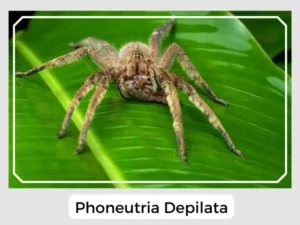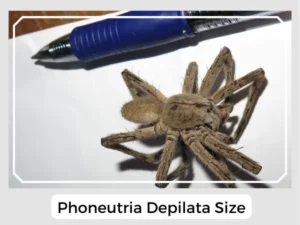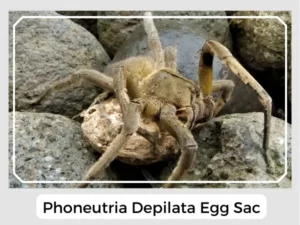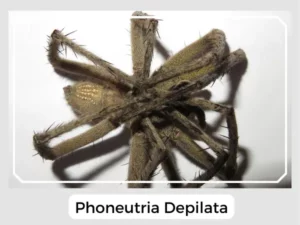The Phoneutria depilata is a member of wandering spiders. It lives in Central America and is pretty interesting. We’ve gathered some fun facts about this spider, and we’re excited to share them with you right in this blog post!

Photo Credit: Roman Willi

Photo Credit: Kelsey J.R.P. Byers
The eggs are laid inside a sac made of webbing.

Photo Credit: Manuel V Ortiz
Approximately 28-34 days later, the spiderlings emerge, ready to start their journey in the wild.
Since these spiders are wandering hunters, they do not build elaborate webbing for catching prey.
Like other spiders in its genus, they possess very strong venom. A bite from these spiders causes great pain but is generally not fatal.
They can bite if they feel threatened or endangered.
Phoneutria depilata plays a crucial role in maintaining the ecological balance within its habitat. By preying on various amphibians, mice, and reptiles, it helps control the population of these species, ensuring a stable and healthy ecosystem. The spider’s nocturnal and wandering nature highlights its adaptability, as it navigates through the complexity of the tropical forests with ease.
Natural Predators: Despite its venomous bite, Phoneutria depilata is not without its own set of predators. Birds and larger mammals pose a threat to this spider, creating a balanced prey-predator dynamic within the ecosystem.
Prey-Predator Dynamics: The relationship between Phoneutria depilata and its prey and predators showcases the delicate balance of nature. The spider’s venomous bite allows it to subdue its prey effectively, while its agility aids in evading predators, ensuring its survival and contribution to the ecosystem’s stability.
Relationship with Humans: While encounters with humans are relatively rare due to the spider’s reclusive nature, it is crucial to approach Phoneutria depilata with caution and respect. Understanding its role in the ecosystem and acknowledging its right to thrive in its natural habitat fosters a harmonious coexistence, minimizing potential risks and conflicts.

Photo Credit: Kelsey J.R.P. Byers
| Lifespan | 1-2 years |
| Distribution | Central America |
| Habitat | Tropical forests |
| Diet | Amphibians, mice, and reptiles |
In conclusion, Phoneutria depilata stands as a testament to the diversity and complexity of the arachnid world.
The Phoneutria depilata is a member of wandering spiders. It lives in Central America and is pretty interesting. We’ve gathered some fun facts about this spider, and we’re excited to share them with you right in this blog post!

Photo Credit: Roman Willi

Photo Credit: Kelsey J.R.P. Byers
The eggs are laid inside a sac made of webbing.

Photo Credit: Manuel V Ortiz
Approximately 28-34 days later, the spiderlings emerge, ready to start their journey in the wild.
Since these spiders are wandering hunters, they do not build elaborate webbing for catching prey.
Like other spiders in its genus, they possess very strong venom. A bite from these spiders causes great pain but is generally not fatal.
They can bite if they feel threatened or endangered.
Phoneutria depilata plays a crucial role in maintaining the ecological balance within its habitat. By preying on various amphibians, mice, and reptiles, it helps control the population of these species, ensuring a stable and healthy ecosystem. The spider’s nocturnal and wandering nature highlights its adaptability, as it navigates through the complexity of the tropical forests with ease.
Natural Predators: Despite its venomous bite, Phoneutria depilata is not without its own set of predators. Birds and larger mammals pose a threat to this spider, creating a balanced prey-predator dynamic within the ecosystem.
Prey-Predator Dynamics: The relationship between Phoneutria depilata and its prey and predators showcases the delicate balance of nature. The spider’s venomous bite allows it to subdue its prey effectively, while its agility aids in evading predators, ensuring its survival and contribution to the ecosystem’s stability.
Relationship with Humans: While encounters with humans are relatively rare due to the spider’s reclusive nature, it is crucial to approach Phoneutria depilata with caution and respect. Understanding its role in the ecosystem and acknowledging its right to thrive in its natural habitat fosters a harmonious coexistence, minimizing potential risks and conflicts.

Photo Credit: Kelsey J.R.P. Byers
| Lifespan | 1-2 years |
| Distribution | Central America |
| Habitat | Tropical forests |
| Diet | Amphibians, mice, and reptiles |
In conclusion, Phoneutria depilata stands as a testament to the diversity and complexity of the arachnid world.